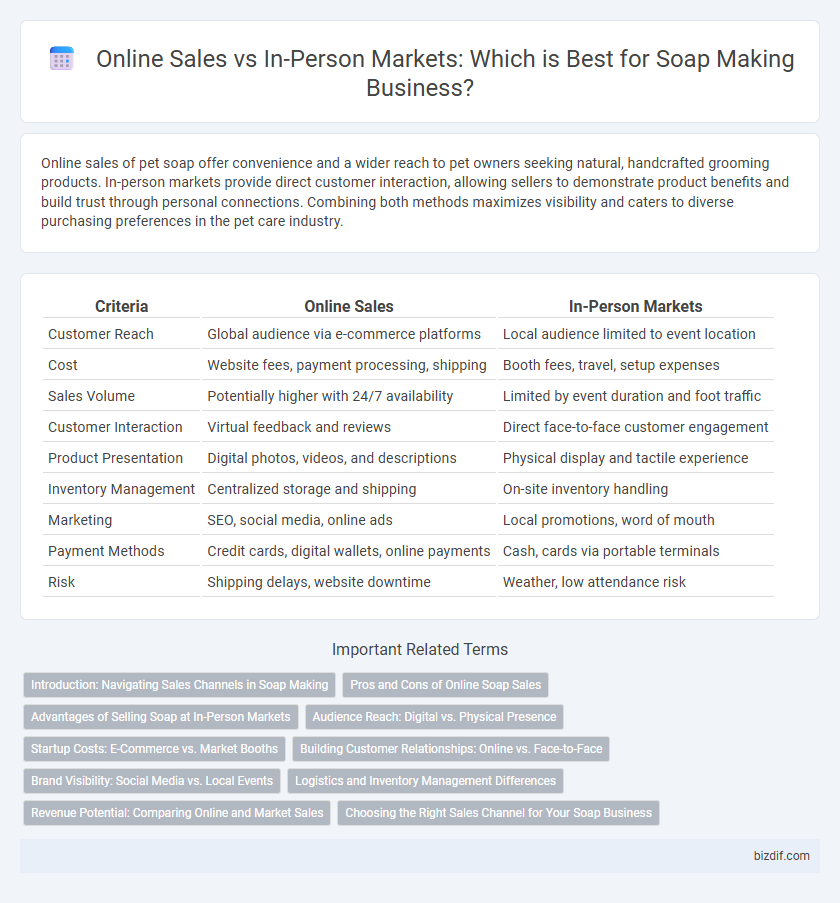Online sales of pet soap offer convenience and a wider reach to pet owners seeking natural, handcrafted grooming products. In-person markets provide direct customer interaction, allowing sellers to demonstrate product benefits and build trust through personal connections. Combining both methods maximizes visibility and caters to diverse purchasing preferences in the pet care industry.
Table of Comparison
| Criteria | Online Sales | In-Person Markets |
|---|---|---|
| Customer Reach | Global audience via e-commerce platforms | Local audience limited to event location |
| Cost | Website fees, payment processing, shipping | Booth fees, travel, setup expenses |
| Sales Volume | Potentially higher with 24/7 availability | Limited by event duration and foot traffic |
| Customer Interaction | Virtual feedback and reviews | Direct face-to-face customer engagement |
| Product Presentation | Digital photos, videos, and descriptions | Physical display and tactile experience |
| Inventory Management | Centralized storage and shipping | On-site inventory handling |
| Marketing | SEO, social media, online ads | Local promotions, word of mouth |
| Payment Methods | Credit cards, digital wallets, online payments | Cash, cards via portable terminals |
| Risk | Shipping delays, website downtime | Weather, low attendance risk |
Introduction: Navigating Sales Channels in Soap Making
Online sales platforms like Etsy and Shopify provide soap makers access to a global customer base, offering scalability and detailed analytics for targeted marketing. In-person markets, such as farmers' markets and craft fairs, enable direct customer interaction, immediate feedback, and the opportunity to build community trust with unique handcrafted products. Choosing the right sales channel depends on the soap maker's goals, product range, and desired customer engagement level.
Pros and Cons of Online Soap Sales
Online soap sales offer a broader market reach, enabling artisans to sell their products globally without geographic limitations. The convenience of 24/7 availability and lower overhead costs compared to physical markets enhances profitability, though challenges include increased competition, reliance on digital marketing, and the inability for customers to physically inspect products before purchase. Managing shipping logistics and ensuring product safety during transit are essential considerations for maintaining customer satisfaction in online soap sales.
Advantages of Selling Soap at In-Person Markets
Selling soap at in-person markets allows direct customer interaction, fostering trust and immediate feedback that can enhance product development. These markets provide opportunities for brand storytelling and sensory experiences, enabling customers to smell and test soaps before purchasing. In-person sales often result in higher impulse buys and stronger local brand loyalty compared to online sales.
Audience Reach: Digital vs. Physical Presence
Online sales platforms enable soap makers to reach a global audience, expanding potential customer base beyond local geographic limits with targeted digital marketing tools. In-person markets attract local buyers who seek tactile experiences and personal connections, fostering trust and immediate feedback. Combining online reach with physical presence maximizes market visibility and consumer engagement for handcrafted soap businesses.
Startup Costs: E-Commerce vs. Market Booths
E-commerce soap businesses require lower startup costs, primarily involving website development, hosting fees, and digital marketing expenses, which can start as low as $500. In contrast, in-person market booths demand higher upfront investments, including booth rental fees, physical setup materials like displays and signage, and transportation costs, often exceeding $1,000 per event. Optimizing online sales platforms reduces overhead and broadens reach, while market booths offer tangible customer interactions but with increased financial risk.
Building Customer Relationships: Online vs. Face-to-Face
Building customer relationships in soap making varies significantly between online sales and in-person markets. Online platforms offer broad reach through personalized follow-ups and targeted content but may lack the immediacy of sensory engagement and trust developed during face-to-face interactions. In-person markets foster direct communication, allowing artisans to demonstrate product quality and gather instant feedback, which strengthens customer loyalty and brand authenticity.
Brand Visibility: Social Media vs. Local Events
Online sales platforms and social media channels significantly boost soap makers' brand visibility by enabling targeted advertising and wide audience reach. In-person markets foster personal connections and hands-on product experiences that social media cannot replicate, enhancing brand trust and local loyalty. Combining digital presence with community events maximizes exposure and diversifies customer engagement for soap businesses.
Logistics and Inventory Management Differences
Online soap sales require streamlined logistics with reliable shipping carriers, tracking systems, and packaging that ensures product safety during transit, compared to in-person markets where inventory turnover is immediate and requires on-site storage solutions. Inventory management for e-commerce demands real-time stock updates across digital platforms to prevent overselling, while in-person market sales benefit from direct customer interaction and immediate restocking capability. Efficient coordination between supply chain, warehouse organization, and shipping schedules is critical for online sales, contrasting with the localized, manual inventory control inherent in physical market stalls.
Revenue Potential: Comparing Online and Market Sales
Online sales platforms for soap making offer broader customer reach and 24/7 availability, often resulting in higher revenue potential through increased order volumes and scalability. In-person markets provide direct customer interaction, enabling premium pricing through personalized experiences and impulse buying, though revenue is limited by market hours and location constraints. Balancing both sales channels can maximize overall revenue by leveraging online convenience and the tactile appeal of physical markets.
Choosing the Right Sales Channel for Your Soap Business
Online sales offer soap makers a broad reach and 24/7 accessibility, enabling them to tap into global markets and analyze customer preferences through e-commerce analytics. In-person markets provide hands-on experience, direct customer feedback, and the chance to build relationships through sensory engagement, such as scent testing and packaging appeal. Selecting the right sales channel depends on understanding target demographics, product uniqueness, and resource allocation for marketing and logistics.
Online Sales vs In-Person Markets Infographic

 bizdif.com
bizdif.com